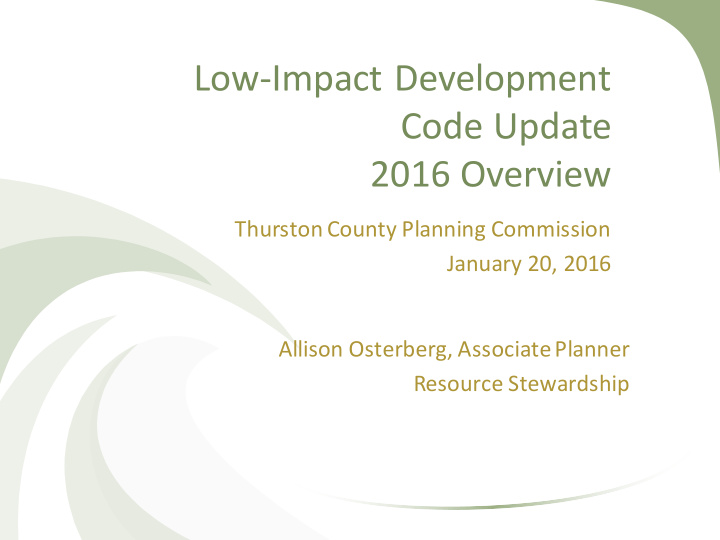



Low-Impact Development Code Update 2016 Overview Thurston County Planning Commission January 20, 2016 Allison Osterberg, Associate Planner Resource Stewardship
What is LID? • Ecology definition: Low-impact development (LID) is a stormwater and land use management strategy that strives to mimic pre-disturbance hydrologic processes of infiltration, filtration, storage, evaporation, and transpiration by emphasizing conservation, use of on-site natural features, site planning, and distributed stormwater management practices that are integrated into a project design. • Key LID Principles Conserve vegetation Reduce and disconnect impervious surfaces Infiltrate runoff on site
Why do we need to update the codes? • NPDES Municipal Stormwater Permit, reissued in 2013 • Review codes to make LID the “preferred and commonly -used approach to site development” • Should consider measures to minimize: Impervious surfaces Loss of native vegetation Stormwater runoff • Deadline: December 31, 2016
How are the codes reviewed? • Internal County Workgroup Multiple county departments Provided initial recommended changes • Community Stakeholder Advisory Group Provided feedback Includes representatives from developers, builders, realtors, landscapers, contractors, SSWAB, and others • Interjurisdictional Work Group Discussed codes for Lacey, Olympia, Tumwater and UGAs • Planning Commission • Board of Commissioners – Final Adoption
What codes are being reviewed? • Zoning Code (TCC 20) – Parking – Landscaping – Impervious surface limits – Building setbacks and lot sizes • Subdivisions and Open Space (TCC 18) • Clearing and Grading (TCC 14.37) • UGA Codes (Lacey, Tumwater, Olympia) (TCC 21, 22, 23) Also being reviewed, but not by the Planning Commission • Drainage Manual (TCC 15.05) • Road Standards (TCC 15.04)
2016 Drainage Design and Erosion Control Manual Revision Mark Maurer, PE, PLA Stormwater Utility Planner Thurston County http://www.co.thurston.wa.us
Thurston County Mission “ Creating Solutions for our Future.” Thurston County http://www.co.thurston.wa.us
Goal of this Presentation- Give an overview of the DDECM changes and how it fits into the LID code revision Thurston County http://www.co.thurston.wa.us
Water Cycle Information/photos? Thurston County http://www.co.thurston.wa.us
“Traditional” vs. LID Thurston County http://www.co.thurston.wa.us
DDECM What is the DDECM? How do we use it? What is changing with the 2016 revision? Thurston County http://www.co.thurston.wa.us
What is the DDECM? It’s a technical manual that: • Establishes minimum requirements for projects regarding stormwater, • Gives guidelines for designing stormwater systems for treatment and flow control. Thurston County http://www.co.thurston.wa.us
How do we use it? • County employees use it to determine if projects are meeting the minimum requirements • Developers and designers use it to know what is required and to correctly design their projects to meet those requirements Thurston County http://www.co.thurston.wa.us
What is changing with the 2016 revision? • Incorporates new requirements from the NPDES permit • LID is now a requirement • Additional LID infeasibility criteria • Projects must use a list of LID BMPs or meet the LID flow control standard Thurston County http://www.co.thurston.wa.us
What is changing with the 2016 revision? • Flow control standard 50% of the 2 year to the 50 year storm event • LID flow control standard 8% of the 2 year to 50% of the two year storm event Thurston County http://www.co.thurston.wa.us
LID BMP’s Bullet Points? Information? Photos? Porous Pavement Bioretention Area Rain Garden Thurston County http://www.co.thurston.wa.us
LID BMP’s Dispersion Area Downspout Infiltration Thurston County http://www.co.thurston.wa.us
Questions? Thurston County http://www.co.thurston.wa.us
LID Infeasibility Criteria • Mostly follow the site suitability criteria in the 2009 manual, i.e., set backs from steep slopes, erosive soils, contaminated areas, landfills, high ground water, septic drain fields, etc. • LID is infeasible if the initial infiltration rate is less than 0.30 inches per hour Thurston County http://www.co.thurston.wa.us
65/10 • Full dispersion applies to sites with a maximum of 10% effective impervious and the water from that area is dispersed through 65% of the site • Sites that meet the 65/10 rule do not trigger the flow control facility req. Thurston County http://www.co.thurston.wa.us
LID Code Update Schedule • February – May: Code Review Work Sessions Feb 3: Olympia UGA April: Lacey & Tumwater UGAs May/June: Public Hearing on All Code Changes July: PC Recommendation August: BoCC Public Hearing September-December: BoCC Decision/Adoption
Questions? Staff Contact Allison Osterberg osterba@co.thurston.wa.us (360) 754-3355 x7011 Project Website http://www.co.thurston.wa.us/waterresources/lid
Recommend
More recommend